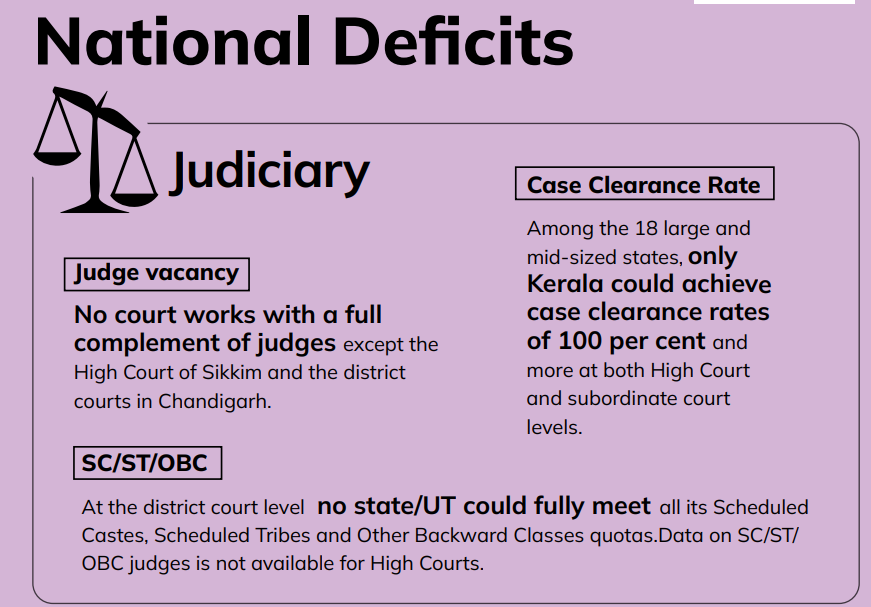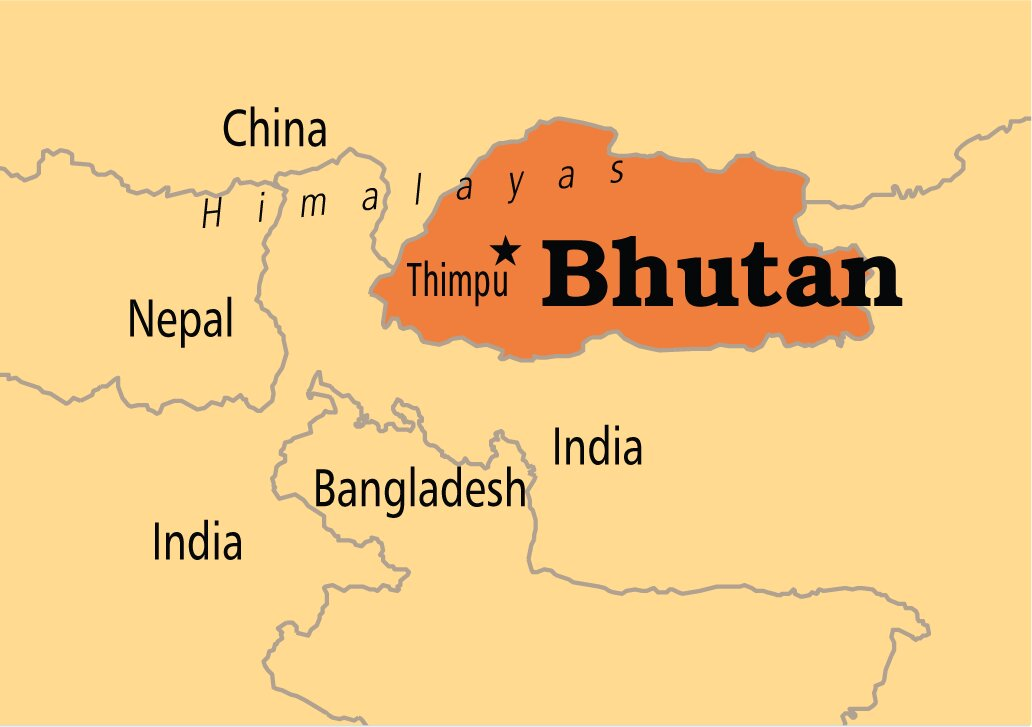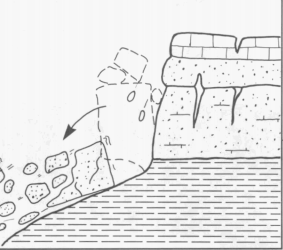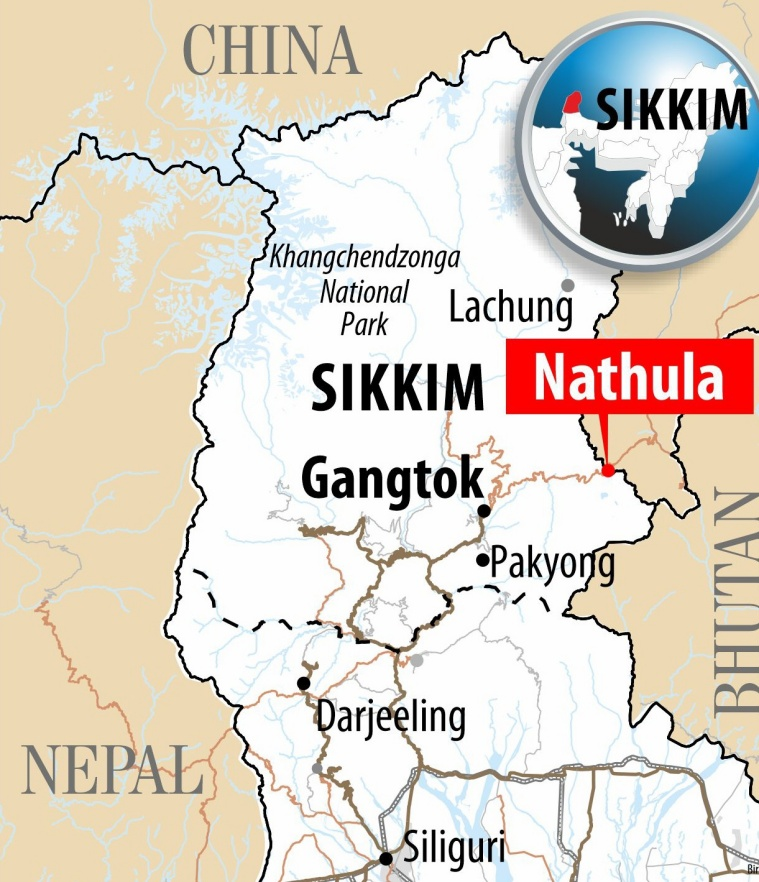India Justice Report 2022
For Prelims: Indian judiciary, Case clearance rates, High Courts and Lower Courts.
For Mains: India Justice Report 2022.
Why in News?
According to the India Justice Report (IJR) 2022, Karnataka has achieved the top rank among the 18 large and mid-sized states in delivery of justice with populations over one crore.
- Tamil Nadu has ranked in the second position; Telangana third; and Uttar Pradesh is at rank 18 which is the lowest.
What is IJR?
- The IJR is an initiative of Tata Trusts in collaboration with Centre for Social Justice, Common Cause and Commonwealth Human Rights Initiative among others.
- It was first published in 2019.
- It assesses the performance of states in terms of justice delivery, by considering several parameters such as police, judiciary, prisons, and legal aid to assess the overall performance of each state.
What are the Key Highlights of the Report related to Judiciary?
- Ranking of Justice Delivery:
- The list of 7 Small States with a population less than one crore each, was topped by Sikkim which was ranked second in 2020.
- Sikkim has been followed by Arunachal Pradesh and Tripura. The State of Goa is at rank Seven which is the lowest.
- Shortage of Judges:
- The Indian judiciary is facing a severe shortage of judges and infrastructure, leading to rising pendency, increasing caseloads, and declining case clearance rates (CCR) in lower courts.
- As of December 2022, the High Courts were functioning with only 778 judges against a sanctioned strength of 1,108 judges.
- The Indian judiciary is facing a severe shortage of judges and infrastructure, leading to rising pendency, increasing caseloads, and declining case clearance rates (CCR) in lower courts.
- Pendency:
- The number of cases pending per judge is rising in most states over the last five years, while the sanctioned strength has remained the same.
- The average pendency in High Courts is highest in Uttar Pradesh (11.34 years) and West Bengal (9.9 years), while it is lowest in Tripura (1 year), Sikkim (1.9 years), and Meghalaya (2.1 years).
- The number of cases pending per judge is rising in most states over the last five years, while the sanctioned strength has remained the same.
- Increased Caseload:
- The caseload per judge has steadily increased, with the caseload per judge increasing in 22 states and Union Territories between 2018 and 2022.
- Case Clearance Rate:
- The CCR in High Courts improved by six percentage points (88.5% to 94.6%) between 2018-19 and 2022 but declined by 3.6 points in lower courts (93% to 89.4%).
- High Courts are increasingly clearing more cases annually than subordinate courts.
- In 2018-19, only four High Courts had a CCR of 100% or more. In 2022, this more than double to 12 High Courts.
- Court Halls:
- Nationally, the number of court halls appears sufficient for the number of actual judges, but space will become a problem if all the sanctioned posts are filled.
- In August 2022, there were 21,014 court halls for the 24,631 sanctioned judges' posts, a shortfall of 14.7%.
- Recommendations:
- The shortage of judges and infrastructure is a significant concern for the Indian judiciary, leading to a rise in pendency and declining CCR in lower courts. The government needs to address this issue by filling the vacant judge posts, providing adequate infrastructure, and taking measures to improve the efficiency of the judicial system.
- There is a need for better police training and infrastructure, reducing overcrowding in prisons, and improving the speed and efficiency of the judicial system.
- There should be greater attention to be paid to the needs of victims of crime, including improving access to legal aid and victim compensation schemes.
- By addressing these challenges, India can move closer to achieving a more equitable and effective criminal justice system.
What are Other Findings?
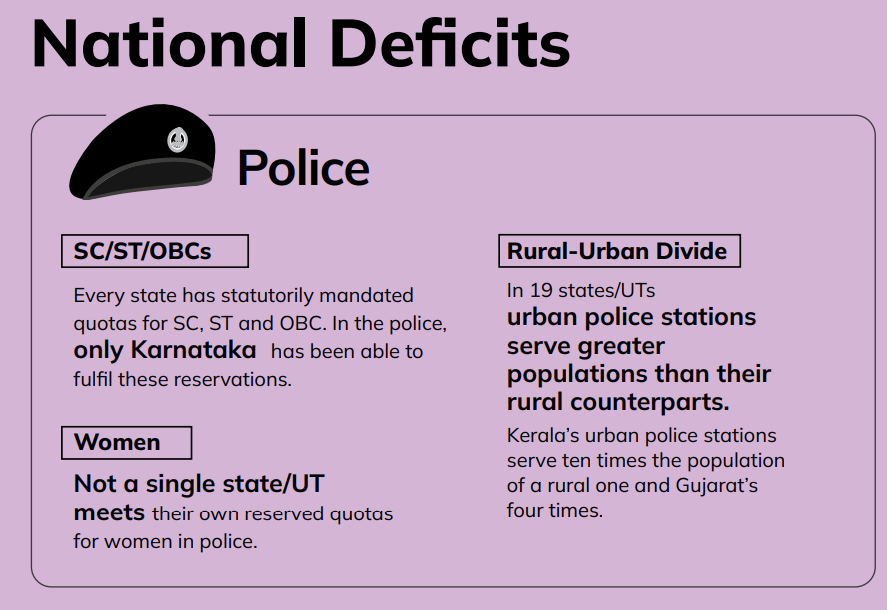 |
|
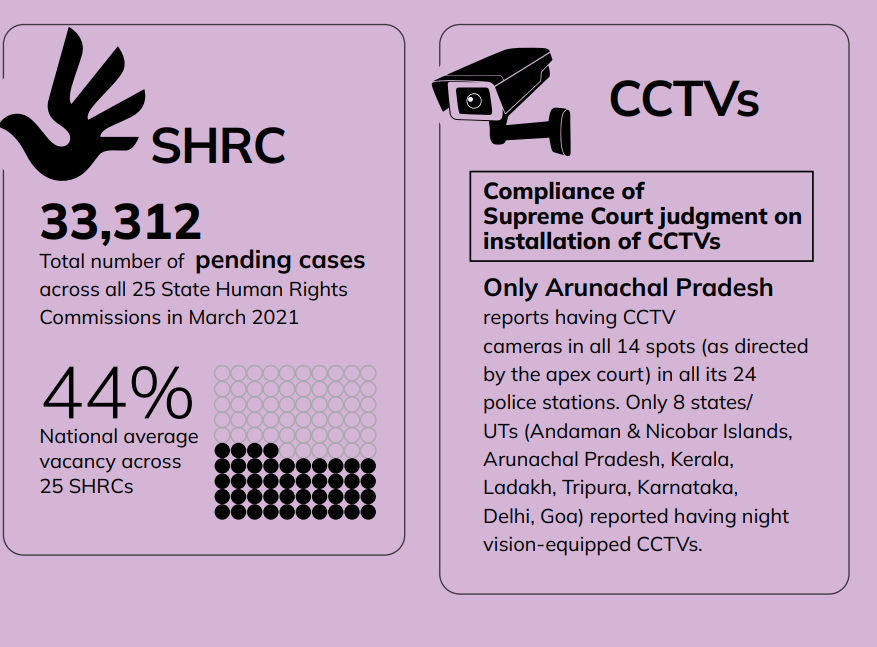 |
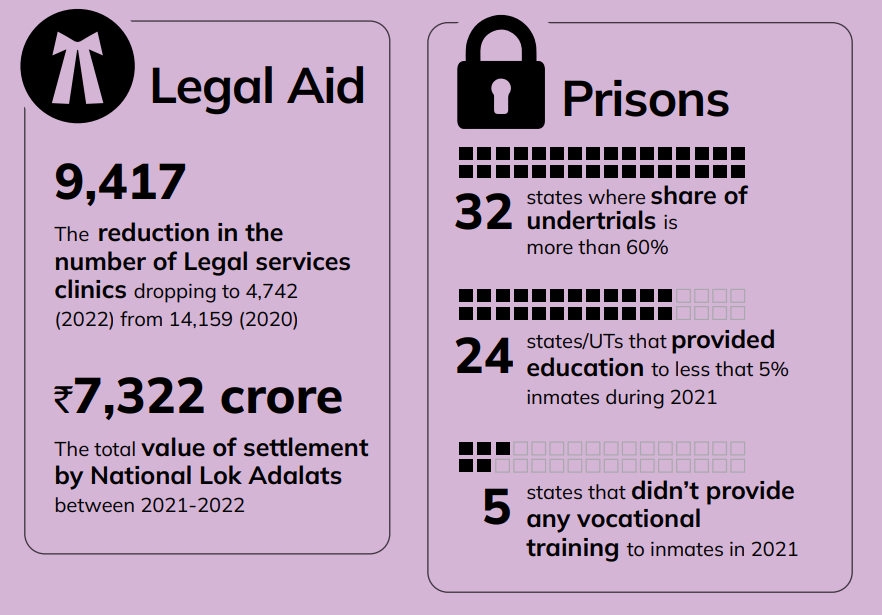 |
Vaikom Satyagraha
For Prelims: Leaders of Vaikom satyagraha, factors leading to satyagraha.
For Mains: Significance, role of women in Vaikom satyagraha.
Why in News?
As the year 2024 marks the centenary of the Vaikom Satyagraha, Chief Minister of Kerala and Tamil Nadu jointly inaugurated the centenary celebrations.
What is Vaikom Satyagraha?
- Background:
- The princely state of Travancore had a feudal, militaristic, and ruthless system of custom-ridden government, some of the most rigid, refined and ruthless social norms and customs were seen in Travancore.
- Lower castes like the Ezhavas and Pulayas were considered polluting and various rules were in place to distance them from upper castes.
- These included a prohibition, not just on temple entry, but even on walking on the roads surrounding temples.
- The princely state of Travancore had a feudal, militaristic, and ruthless system of custom-ridden government, some of the most rigid, refined and ruthless social norms and customs were seen in Travancore.
- Contribution of Leaders:
- In 1923, Madhavan presented the issue as a resolution at the Kakinada meet of All India Congress Committee. Subsequently, it was taken up by the Congress Untouchability Committee formed by the Kerala Pradesh Congress Committee in January 1924.
- Madhavan, K.P. Kesava Menon who was the then secretary of Kerala Pradesh Congress Committee and Congress leader and educationist K. Kelappan (also known as Kerala Gandhi) are considered the pioneers of the Vaikom Satyagraha movement.
- Factors Leading to Satyagraha:
- Christian missionaries, supported by the East India Company, had expanded their reach and many lower castes converted to Christianity to escape the clutches of an oppressive system that continued to bind them.
- Maharaja Ayilyam Thirunal, took many progressive reforms.
- Most important of these was the introduction of a modern education system with free primary education for all – even lower castes.
- Forces of capitalism and these reforms created new social hierarchies – which were not always congruent with traditional ones.
- Beginning of Satyagraha:
- On March 30, 1924, the Satyagrahis walked in procession towards the forbidden public roads. They were stopped 50 yards away from the place where a board cautioning the oppressed communities against walking on the roads (surrounding the Vaikom Mahadeva temple), was placed.
- Dressed in khadi and wearing khadi caps, Govinda Panikkar (Nair), Bahuleyan (Ezhava) and Kunjappu (Pulaya),defied the prohibitionary orders.
- The police stopped them. In protest, the three men sat on the road and were arrested.
- Then on, every day, three volunteers from three different communities were sent to walk on the prohibited roads.
- Within a week, the leaders of the movement were all arrested.
- Role of Women:
- Periyar’s wife Nagammai and sister Kannammal, played an unprecedented role in the fight.
- Arrival of Gandhi:
- Gandhi arrived at Vaikom in March 1925, held a series of discussions with leaders of various caste groups and met Maharani Regent at her Varkala camp.
- The Vaikom Satyagraha was officially withdrawn on November 30, 1925 after consultations between Gandhi and W.H. Pitt (police commissioner of Travancore).
- A compromise was reached following the release of all prisoners and grant of access to roads.
- Temple Entry Proclamation:
- In 1936, the historic Temple Entry Proclamation was signed by the Maharaja of Travancore which removed the age-old ban on the entry of temples.
- Significance:
- Amidst rising nationalist sentiment and agitations across the country, it foregrounded social reform.
- For the first time, it brought Gandhian methods of nonviolent protest to Travancore.
- The movement continued for over 600 days, non-stop, through social pressure, police crackdowns and even natural disaster in 1924, is admirable.
- The Vaikom satyagraha saw previously unseen unity across caste lines.
Conclusion
Till 1917, the Indian National Congress refused to take up social reform. But with the rise of Gandhi and increased activism within lower caste communities and untouchables, social reform soon found itself front and Centre of Congress’s and Gandhi’s politics.
Limiting Salt Intake
For Prelims: WHO, Hypertension, Cardiovascular Diseases, Eat Right India Campaign, SDG, FSSAI.
For Mains: Need for Limiting Salt Intake.
Why in News?
The World Health Organization (WHO) recommends a daily intake of less than 5 grams of salt for adults, but an average Indian's sodium consumption is more than double that amount.
- The WHO has set a goal for member states to reduce population sodium intake by 30% by 2025, but progress has been slow. India's sodium score of 2 out of 4 indicates the need for more rigorous efforts to address this health concern.
- The WHO recently published the ‘Global Report on Sodium Intake Reduction,’ which sheds light on the progress of its 194 member states towards reducing population sodium intake by 30% by 2025.
What is the Need for Limiting Salt Intake?
- Excessive salt intake can have dangerous consequences such as Hypertension, heart disease, and stroke.
- Reducing sodium intake is important because it is strongly correlated with lower blood pressure, which can lead to a decrease in Cardiovascular Diseases.
- Cardiovascular disease is the leading cause of mortality worldwide and is responsible for a significant economic impact on low- and middle-income countries (LMICs) such as India.
- Cardiovascular disease and hypertension are significant challenges in India due to several factors, including rising mortality rates, higher prevalence in men, particularly in southern states, and a large pre-hypertensive population.
- The 2020 Report on Medical Certification of the Cause of Death shows that circulatory system diseases account for 32.1% of all documented deaths in India, with hypertension being a major risk factor.
- The World Economic Forum projects that the Indian economy alone faces losses surpassing USD 2 trillion between 2012 and 2030 because of cardiovascular disease.
What are the Related Initiatives?
- Eat Right India Campaign:
- It was launched by the Food Safety and Standards Authority of India (FSSAI), aiming to transform the Indian food system and ensure that everyone has access to safe, nutritious, and sustainable food.
- Aaj Se Thoda Kam Campaign:
- FSSAI has initiated the 'Aaj Se Thoda Kam' social media campaign. Despite these efforts, the average sodium consumption of Indians remains alarmingly high. Studies have found that the typical daily intake of sodium in India is around 11 grams, which is much higher than the recommended intake of 5 grams per day.
Why is Salt Consumption Important?
- Salt as a Sodium chloride is an essential nutrient that plays several important roles in the body.
- Sodium is an electrolyte that helps to regulate the balance of fluids in the body and aids in the transmission of nerve impulses and muscle contractions.
- Salt consumption is important for maintaining proper bodily function, but excessive intake can have negative health consequences, making it important to consume salt in moderation.
How can the Related Challenges be Addressed?
- India needs a comprehensive national strategy to reduce salt consumption, with a multi-pronged approach that engages consumers, industry, and the government. Collaboration between state and union governments is essential to combat hypertension caused by excessive sodium intake.
- Reducing sodium consumption has been identified as a highly cost-effective strategy to prevent Non Communicable Diseases (NCDs), which are responsible for the majority of deaths worldwide.
- A report suggests that implementing policies to reduce sodium consumption could save an estimated seven million lives globally by 2030.
- The sodium reduction policy is crucial to achieving the Sustainable Development Goal (SDG) of reducing deaths from NCDs.
United Nations 2023 Water Conference
For Prelims: United Nations, SDG, Water conference, Jal Kranti Abhiyan, National Water Mission, National Rural Drinking Water Programme, NITI Aayog Composite Water Management Index, Jal Jeevan Mission, Jal Shakti Abhiyan, Atal Bhujal Yojana.
For Mains: Global Water Scarcity and related Steps taken, Water Resources, Conservation of Resources.
Why in News?
Recently, the United Nations held its first water conference in 46 years on March 22-24 in New York. The conference coincided with the mid-term review of the International Decade for Action.
- The U.N. recognized that we are not doing enough to meet SDG 6, which aims to provide clean water and sanitation for everyone by 2030.
- The urgent need for action was demonstrated by a report "Water for Sustainable Development 2018-2028."
What is a Water Conference?
- About:
- The water conference brings together people from different countries and organizations to work together on solving global water challenges. Water problems are usually local, but by working together, countries can learn from each other, share technology, and invest in solutions.
- The UN 2023 Water Conference's theme, "Our watershed moment: uniting the world for water," aimed to support the achievement of water-related global goals and objectives, including those enumerated in the 2030 Agenda for Sustainable Development.
- Background:
- The last water conference was held in 1977 (in Mar Del Plata, Argentina) and resulted in a global action plan to provide safe drinking water for everyone. This plan helped reduce the number of people without access to safe drinking water in many developing countries.
What are the Outcomes of the New Water Conference?
- The complexity of today’s water problems was reflected in the conference’s proceedings, resulting in fragmented discussions, and no binding commitments. Instead, there were 713 diverse voluntary commitments by philanthropic donors, governments, corporations, and NGOs. The following are some commitments announced at the event, with examples of projects that showed potential:
- Technology:
- There were specific innovations in wastewater treatment or solar treatment of water in remote areas, and several proposals for incubation platforms, including the IBM Sustainability Accelerator, focused on water management.
- Data and Models:
- Before every large investment, we must anticipate potential impact. Simulations are often important to do this, and they need large amounts of input data. Cost-effective approaches to data-generation included sensors and satellite data. Other efforts, like the World Meteorological Organization's Hydrological Status and Outlook System, offered data analysis tools.
- Knowledge Sharing:
- Solutions to most of these problems already exist, but each region and country often reinvents the wheel. We need to accelerate cross-learning.
- One useful tool here was the W12+ Blueprint, a UNESCO platform that hosts city profiles and case studies of programs, technologies, and policies that address common water security challenges.
- Solutions to most of these problems already exist, but each region and country often reinvents the wheel. We need to accelerate cross-learning.
- Capacity Building:
- Many people lack access to basic services because they are unable to advocate for themselves and because infrastructure projects are designed for and by powerful actors in society. Efforts like the Making Rights Real initiative offered to help marginalized communities and women understand how to exercise their rights.
- The ‘Water for Women Fund’ offered support mechanisms for more effective and sustainable water, sanitation, and hygiene outcomes for women.
- Incentives:
- The conference highlighted that the lack of incentives is a major hindrance for farmers and industries to use water efficiently and sustainably.
- The integration of environmental, social, and corporate governance into the Water Action Agenda is a positive step towards effective water governance.
- However, the success of these commitments depends on how they are carried forward during the HLPF (High-level Political Forum) and the COP28 climate talks to be held in Dubai. It is crucial for consumers to be willing to pay a premium for sustainably produced goods to encourage farmers to adopt sustainable practices.
- The conference highlighted that the lack of incentives is a major hindrance for farmers and industries to use water efficiently and sustainably.
- Technology:
What are the Challenges Need to Address?
- The water sector is particularly prone to fragmentation because water problems tend to be local and need local solutions.
- The conference had ambitious goals, including identifying game-changing ideas, making recommendations to policymakers on how to speed- and scale-up change, placing water at the centre of the climate agenda, and learning from the experiences of others, transfer technology, and invest.
- Improving access to safe drinking water and sanitation is not enough to ensure sustained access to these resources. Groundwater over-abstraction, which is mostly driven by agricultural pumping, is a major problem that leads to water scarcity and contamination.
- In places like Punjab or the Cauvery delta, where there is heavy irrigation, the only solution is to pump less water. This, however, requires agricultural policies to change, which in turn requires collaboration among different agencies and ministries.
- The problem is no longer just about access to water and sanitation, but also about sustaining agriculture, industry, and natural ecosystems.
- The remaining SDG 6 targets aim to address this issue by promoting better governance, improving efficiency of irrigation water use, restoring water quality in lakes and rivers, and improving wastewater management. These problems cannot be solved by infrastructure alone, but require tough political choices, agency empowerment, and strengthening democratic processes.
What are India's Initiatives on Clean Water, and sanitation?
- Swachh Bharat Mission
- Jal Jeevan Mission
- Jal Kranti Abhiyan.
- National Water Mission.
- National Rural Drinking Water Programme.
- NITI Aayog Composite Water Management Index.
- Jal Shakti Abhiyan.
- Atal Bhujal Yojana
UPSC Civil Services Examination Previous Year Question (PYQ)
Q. What are the salient features of the Jal Shakti Abhiyan launched by the Government of India for water conservation and water security? (2020)
Bhutan’s King Visits India
For Prelims: Chhukha hydro-electric project, Integrated Check Post along the India-Bhutan border, STEM-based initiatives, Bharat Interface for Money.
For Mains: India-Bhutan Relations.
Why in News?
Bhutan’s King visited India and met the Indian Prime Minister, where both leaders discussed bilateral cooperation and issues of national and regional interests.
What are the Key Highlights of the Meeting?
- Bhutan's Development Plans:
- The focus was primarily on Bhutanese's Transformation Initiatives and Reforms Process, as well as India's support for Bhutan's development plans, including the 13th Five Year Plan that starts from next year 2024.
- Bhutan is set to graduate from the list of Least Developed Countries in 2023 and aims to turn into a developed country with a per-capita income of USD 12,000 in the next ten years.
- Credit Facility and Financial Support:
- India has agreed to extend Bhutan a third additional standby credit facility and has also discussed financial support for reforms and institutional capacity building, infrastructure and connectivity projects, energy cooperation including hydropower and solar energy projects, as well as space cooperation, including the recent launch of the India-Bhutan satellite.
- Power Tariff for Hydro-Electric Project:
- The Indian government has agreed to a long-pending demand from Bhutan to increase the power tariffs for the Chhukha hydro-electric project, which began operations with India's help in 1986.
- Furthermore, India has agreed to discuss buying power from the Basochhu hydel project that was built with Austrian support in 2008.
- Sankosh Hydel Project:
- The two sides will also try to expedite negotiations on the reservoir-based 2,500 MW Sankosh hydel project, which has been stuck for decades due to environmental and cost concerns.
- Integrated Check Post:
- India is also examining the possibility of setting up the first Integrated Check Post along the India-Bhutan border at Jaigaon and expediting the proposed Kokrajhar-Gelephu rail link project.
- Rail and Air Link:
- Bhutan is constructing its second international airport at Gelephu, near the border with India, and the rail link project would help build the southern Bhutanese city into a hub for attracting international investment.
- Digital Infrastructure:
- Cooperation in newer areas beyond the traditional realms of cooperation such as new STEM-based initiatives, establishment of digital infrastructure such as the Third International Internet Gateway, integration of Bhutan’s DrukRen with India’s National Knowledge Network – a key cooperation in the domain of e-Learning, E-library project complementing Bhutan’s efforts at digital transformation, e-learning, were also discussed.
- Financial Cooperation:
- Under Financial Cooperation or Integration, the first phase of the RuPay project was launched, India’s Bharat Interface for Money (BHIM) was also launched in July 2021.
- The two sides will also review the implementation of the BHIM app in Bhutan.
How have been Indo-Bhutan Relationships?
- Indo-Bhutan Treaty of Peace and Friendship, 1949:
- The Treaty provides for, among other things, perpetual peace and friendship, free trade and commerce and equal justice to each other’s citizens.
- In 2007 the treaty was re-negotiated, and provisions were included to encourage Bhutan’s sovereignty, abolishing the need to take India’s guidance on foreign policy.
- Multilateral Partnership:
- Both of them share multilateral forums such as South Asian Association for Regional Cooperation (SAARC), BBIN (Bangladesh, Bhutan, India, and Nepal), BIMSTEC (Bay of Bengal Initiative for Multi Sectoral Technical and Economic Cooperation) etc.
- Hydropower Cooperation:
- This hydropower cooperation comes under the 2006 Agreement on Cooperation in Hydropower. Under a protocol to this agreement, India has agreed to assist Bhutan in the development of a minimum of 10,000 MW of hydropower and import of surplus electricity from the same by 2020.
- Four hydro-electric projects (HEPs)- Chhukha, Kurichu, Tala and Mangdechhu totaling 2136 MW are already operational in Bhutan and are supplying electricity to India.
- Two HEPs namely, Punatsangchhu-I, Punatsangchhu-II in Inter-Governmental mode are under various stages of implementation
- Trade:
- The trade between the two countries is governed by the India Bhutan Trade and Transit Agreement 1972 which was last renewed in November 2016.
- In November 2021, the Indian government formalised the opening of seven new trade routes for Bhutan's bilateral and transit trade with India.
- These new routes are expected to boost economic activity in the region and enhance connectivity between the two countries.
- In addition to this, new market access has been provided to allow formal export of 12 agri-products from Bhutan to India, which is expected to provide a major boost to the country's agriculture sector.
- Economic Assistance:
- India is Bhutan’s leading development partner. Since the launch of the First Five Year Plan of Bhutan in 1961, India has been extending financial support to Bhutan’s FYPs. India has allotted Rs 4500 crore to Bhutan’s 12th FYP (2018-23).
- Educational and Cultural Cooperation:
- A large number of college going Bhutanese students study in India. The Government of India provides a number of scholarships to Bhutanese students.
Way Forward
- The importance of environmental sustainability cannot be overstated in the context of Indo-Bhutan relations. Both India and Bhutan are blessed with abundant natural resources, and it is imperative that they work together to preserve and protect these resources for future generations.
- Therefore, it is crucial that India and Bhutan continue to prioritize environmental sustainability in their bilateral relations, and work towards achieving their shared goals of promoting sustainable development and protecting natural resources.
Avalanche
Why in News?
Recently, a massive Avalanche hit Sikkim's Nathu La.
What is Avalanche?
- About:
- An avalanche is a sudden, rapid flow of snow, ice, and debris down a mountain or slope.
- It can be triggered by various factors such as heavy snowfall, rapid temperature changes, or human activity.
- Many regions that are prone to avalanches have specialized teams that monitor and control avalanche risks by using various methods such as explosives, snow barriers, and other safety measures.
- Types:
- Rock Avalanches (which consist of large segments of shattered rock),
- Ice Avalanches (which typically occur in the vicinity of a glacier),
- Debris Avalanches (which contain a variety of unconsolidated materials, such as loose stones and soil).
- Causes:
- Weather Conditions: Heavy snowfall, rapid temperature changes, strong winds, and rain can all contribute to avalanche conditions.
- Slope Conditions: The steepness, orientation, and shape of a slope can contribute to the likelihood of an avalanche occurring. Steep slopes with a convex shape are particularly prone to avalanches.
- Snowpack Conditions: The structure and stability of the snowpack can also contribute to avalanche conditions. Weak layers of snow or ice within the snowpack can cause it to collapse and trigger an avalanche.
- Human Activity: Skiers, snowmobilers, and other recreational users can trigger avalanches by their movements on the slope.
- Natural Events: Earthquakes, volcanic eruptions, and rockfalls can all trigger avalanches.
How are Avalanches different from Landslides?
- Avalanches and landslides are both types of mass movements, but they occur in different environments and involve different materials.
- An avalanche is a rapid flow of snow, ice, and debris down a mountain or slope, while a landslide is a movement of rock, earth, or debris down a slope or cliff.
- Avalanches typically occur in mountainous areas that have heavy snowfall and steep slopes. On the other hand, landslides can occur in a wide range of environments and can be triggered by various factors such as heavy rainfall, earthquakes, volcanic activity, or human activity.
- Both avalanches and landslides can be dangerous and potentially deadly, and it is important to take necessary precautions to avoid them.
What are India's Efforts in Managing Disaster?
- Establishment of National Disaster Reaction Force (NDRF):
- India has increasingly mitigated and responded to all types of disasters, including with the establishment of its NDRF, the world’s largest rapid reaction force dedicated to disaster response.
- India’s Role as a Foreign Disaster Relief:
- India’s foreign humanitarian assistance has increasingly included its military assets, primarily deploying naval ships or aircraft to deliver relief.
- In line with its diplomatic policy of “Neighbourhood First,” many of the recipient countries have been in the region of South and Southeast Asia.
- Contribution to Regional Disaster Preparedness:
- Within the context of the Bay of Bengal Initiative for Multi-Sectoral Technical and Economic Cooperation (BIMSTEC), India has hosted DM Exercises that allow NDRF to demonstrate for counterparts from partner states the techniques developed to respond to various disasters.
- Managing Climate Change related Disaster:
- India has adopted the Sendai Framework for Disaster Risk Reduction, the Sustainable Development Goals (2015-2030), and the Paris Agreement on Climate Change, all of which make clear the connections among DRR, Climate Change Adaptation (CCA), and sustainable development.
What are the Key Facts of Nathu La?
- Nathu La, one of the highest motorable roads in the world, is a mountain pass in the Himalayan peaks situated on the Indo-Tibetan border 14450 ft. above sea level.
- Nathu means 'listening ears', and La means 'pass'.
- It is an open trading border post between India and China.
- The other passes located in the state of Sikkim are Jelep La Pass, Donkia Pass, Chiwabhanjang Pass.
What are the Other Important Passes of India?
| Pass | Link/Features |
| Banihal Pass | Kashmir Valley with the outer Himalaya and the plains to the south. |
| Bara-Lacha-La Pass | Lahaul district in Himachal Pradesh with Leh district in Ladakh. |
| Fotu La Pass | Leh with Kargil of Ladakh |
| Rohtang Pass | Kullu Valley with the Lahaul and Spiti Valleys of Himachal Pradesh. |
| Shipki La Pass | Kinnaur district of Himachal Pradesh with Autonomous Region of Tibet, China. |
| Jelep La Pass | Sikkim with Autonomous Region of Tibet, China. |
| Lipu Lekh Pass | Chaudans valley of India with Autonomous Region of Tibet, China. It is located close to the tri junction of Uttarakhand (India), China and Nepal. |
| Khardung La | Ladakh with Siachen glacier. It is the highest motorable pass in the world. |
| Bom di La | It is in Arunachal Pradesh |
World Bank Forecasts India's Economic Growth Rate
Why in News?
The World Bank has released a report titled "South Asia Economic Focus: Expanding Opportunities: Toward Inclusive Growth," which provides an economic forecast for India, Sri Lanka, and Pakistan.
What are the Major Highlights of the World Bank Report?
- India:
- Growth Rate:
- India's growth rate has been downgraded to 6.3% for FY 2023-24 ,and the report cites high borrowing costs and slower income growth as the primary reasons for this downgrade.
- The female labour participation rate and the size and productivity of the informal sector are also concerns in India.
- However, the services sector and the construction sector are the fastest-growing industries in India, with strong investment growth and high business confidence.
- India's growth rate is expected to grow at 6.4% in FY 2024-25, which is an upgrade of 0.3 % points from the previous forecast.
- India's growth rate has been downgraded to 6.3% for FY 2023-24 ,and the report cites high borrowing costs and slower income growth as the primary reasons for this downgrade.
- Growth Rate:
- Sri Lanka and Pakistan:
- The outlook for Sri Lanka and Pakistan is bleak, with Sri Lanka experiencing a contraction of -4.3% in 2023 and negotiating a USD 3 billion loan from the IMF, while Pakistan is forecasted to have a growth rate of 0.4% for the year ending June 30, 2023.
What are the Major Projects in India Supported by the World Bank?
- India Energy Efficiency Scale-up Program: The development objectives of Energy Efficiency Scale-up Program for India are to scale up energy savings in residential and public sectors, strengthen Energy Efficiency Services Limited’s (EESL) institutional capacity, and enhance its access to commercial financing.
- Pradhan Mantri Gram Sadak Yojana: The project aims to connect unconnected habitations with all-weather roads. Key to the program is an all-weather access to the respective roads.
- Eastern Dedicated Freight Corridor Project: The Government of India and the World Bank today signed a USD 650 million agreement for faster and more efficient movement of raw materials and finished goods between the north and eastern parts of India.
- Innovate in India for Inclusiveness: The development objective of Innovate in India for Inclusiveness is to facilitate innovation in biopharmaceutical products and medical devices that address public health priorities in India.
- National Dairy Support Project: The development objective is to increase the productivity of milch animals and improve market access of milk producers in project areas.
What is World Bank?
- About:
- It was created in 1944, as the International Bank for Reconstruction and Development (IBRD) along with the IMF. The IBRD later became the World Bank.
- The World Bank Group is a unique global partnership of five institutions working for sustainable solutions that reduce poverty and build shared prosperity in developing countries.
- The World Bank is one of the United Nations' specialized agencies.
- Members:
- It has 189 member countries.
- India is also a member country.
- Major Reports:
- Its Five Development Institutions:
- International Bank for Reconstruction and Development (IBRD)
- International Development Association (IDA)
- International Finance Corporation (IFC).
- Multilateral Guarantee Agency (MIGA)
- International Centre for the Settlement of Investment Disputes (ICSID)
- India is not a member of ICSID.
UPSC Civil Services Examination Previous Year Question (PYQ)
Q1. India’s ranking in the ‘Ease of Doing Business Index’ is sometimes seen in the news. Which of the following has declared that ranking? (2016)
(a) Organization for Economic Cooperation and Development (OECD)
(b) World Economic Forum
(c) World Bank
(d) World Trade Organization (WTO)
Ans: (c)
Q2. With reference to ‘IFC Masala Bonds’, sometimes seen in the news, which of the statements given below is/ are correct? (2016)
- The International Finance Corporation, which offers these bonds, is an arm of the World Bank.
- They are the rupee-denominated bonds and are a source of debt financing for the public and private sector.
Select the correct answer using the code given below:
(a) 1 only
(b) 2 only
(c) Both 1 and 2
(d) Neither 1 nor 2
Ans: (c)
Rapid Fire Current Affairs
National Maritime Day
On April 5th, India celebrated National Maritime Day, which commemorates the maiden voyage of the first Indian commercial vessel, the SS Loyalty, from Mumbai to London in 1919. This year's theme was "Propelling Indian Maritime to Net Zero." It was organized by the Directorate General of Shipping, Ministry of Ports, Shipping and Waterways in Mumbai concluded with a ceremony at the Domestic Cruise Terminus in Mumbai Port Trust, highlighted the need for a coordinated and collaborative approach to achieve the net-zero target in the maritime sector.
The Government has acknowledged the contribution of seafarers during the pandemic and emphasized India’s efforts to promote ‘Ease of Doing Business” to reduce logistics costs and facilitate shipping to make India a pre-eminent player in the maritime sector. And the importance of academic partnerships with global maritime universities and enhancing the skills of Indian maritime institutes to achieve the goals of Maritime Vision 2030. During the program, Sagar Samman Awards were awarded to the contributors to the growth of the Indian maritime industry.
Read more: Maritime Vision 2030
GI Tag for Ladakh's Wood Carving
Recently, The Geographical Indication (GI) Registry in Chennai, responsible for registering products under the GI Act, 1999, has awarded the registration to Ladakh's wood carving. The GI registration ensures that the product has a unique identity and origin, and it cannot be duplicated or sold under the same name by any other manufacturer from a different region.
Ladakh's wood carving is renowned for its intricate designs and unique patterns that are mostly inspired by Buddhist themes and motifs. Local wood such as willow and apricot are used to make these wood carvings, which are often used to decorate doors, windows, and other household items.
Read more: Geographical Indication (GI)
GI Tag for Banarasi Paan
Recently, Banarasi Paan is granted with GI tag, Religious and tourist city Kashi has emerged as a GI hub. Special Banarasi Langda Mango, Banarasi Paan, Ramnagar's Bhanta (White Big Round Brinjal), and Adamchini Rice (District Chandauli) have got the Geographical Indications and Intellectual Property Rights (IPR) tag.
Not only ‘Banarasi Paan’, but Mathura’s ‘Peda’, Agra’s ‘Petha’ and Kanpur’s ‘Sattu’ and ‘Bukunu’ would also get tags as part of efforts of the Uttar Pradesh government to provide wider recognition to local goods. After the success of the One District One Product (ODOP), aiming to provide wider recognition to local goods.
India Targets 500 GW Non-Fossil Fuel Capacity by 2030
The Indian government has announced a plan to invite bids for 50 GW of renewable energy capacity annually for the next five years, starting from the financial year 2023-24, which will include the setting up of at least 10 GW of wind power capacity each year. The aim of this plan is to achieve the target of 500 GW of installed electricity capacity from non-fossil fuel sources, including nuclear, by 2030. India currently has a total renewable energy capacity of 168.96 GW, with around 82 GW at different stages of implementation and about 41 GW under tendering stage.
This plan is in accordance with the Prime Minister's announcement at COP26 and is a significant step towards achieving a faster energy transition. Renewable energy projects typically take 18-24 months for commissioning, so this bid plan will add 250 GW of renewable energy and ensure 500 GW of installed capacity by 2030. The targeted bid capacity for FY 2023-24 would be allocated among the four Renewable Energy Implementing Agencies (REIAs), namely Solar Energy Corporation of India Ltd. (SECI), NTPC Ltd., NHPC Ltd., and SJVN Ltd.
Read more: India’s Green-Energy Transition
Ice Memory
A team of Arctic scientists from Italy, France, and Norway are embarking on a mission to extract samples of ancient ice before they melt away due to climate change. The researchers have set up camp in Norway's Svalbard archipelago and will drill ice tubes from as far as 125 meters below the surface, containing frozen geochemical traces dating back three centuries. These ice cores will be used for immediate analysis while a second set will be sent to an "ice memory sanctuary" in Antarctica for future generations of scientists. Extraction is a race against time to preserve crucial ice records that provide valuable data about past environmental conditions. Human-caused carbon emissions have warmed the planet by 1.1 degrees Celsius since the 19th century, and the Arctic is warming between two and four times faster than the global average.
Read more: Rapidly Melting Antarctic Ice

